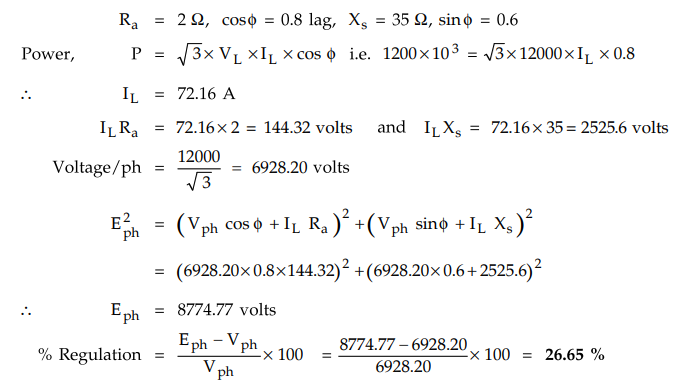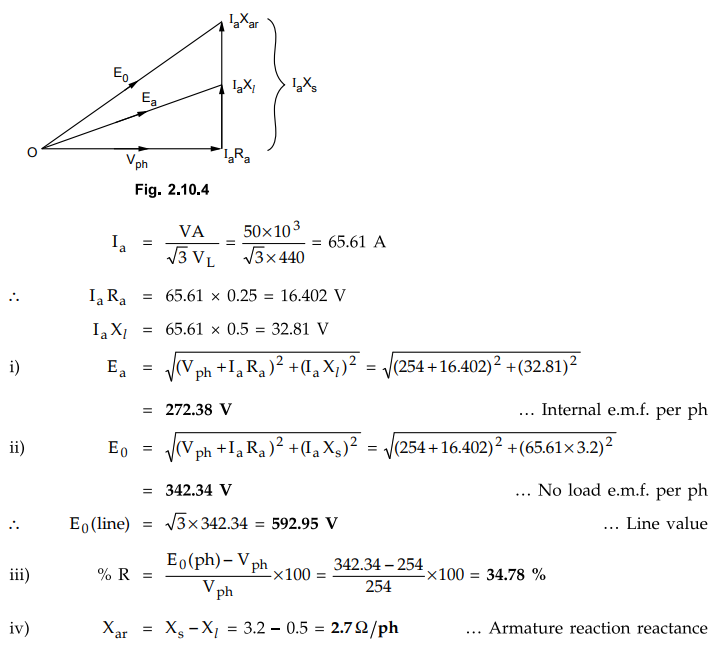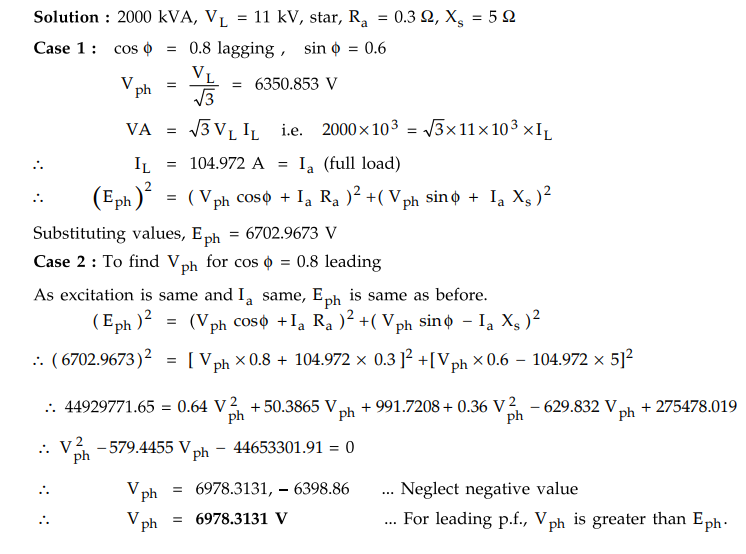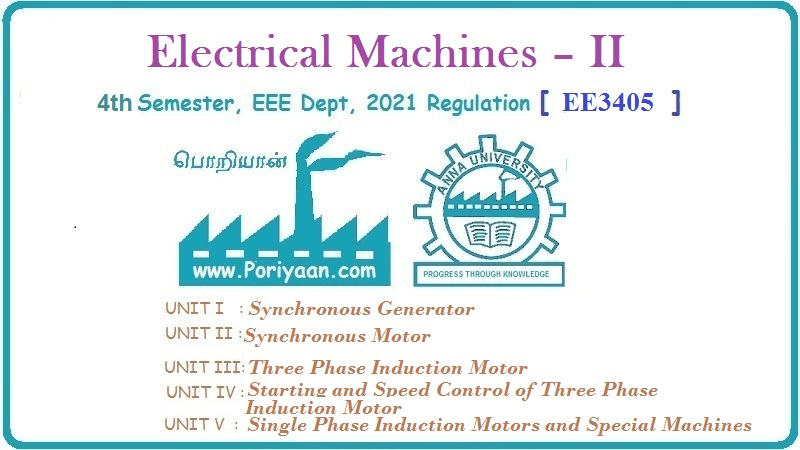Electrical Machines II: UNIT I: b. Armature Reaction and Regulation of Alternators
Voltage Regulation of an Alternator
Under the load condition, the terminal voltage of alternator is less than the induced e.m.f. Eph.
Voltage Regulation of an Alternator AU
: Oct.-97, April-01, 04, May-05, 07,16, Dec.-06
Under
the load condition, the terminal voltage of alternator is less than the induced
e.m.f. Eph. So if load is disconnected, Vph will change
from Vph to Eph, if flux and speed is maintained
constant. This is because when load is disconnected, Ia is zero
hence there are no voltage drops and no armature flux to cause armature
reaction. This change in the terminal voltage is significant in defining the
voltage regulation.
Key Point : The voltage regulation
of an alternator is defined as the change in its terminal voltage when full
load is removed, keeping field excitation and speed constant, divided by the
rated terminal voltage.
So
if Vph = Rated terminal voltage
Eph
= No load induced e.m.f.
then
voltage regulation is defined as,
%
Regulation = Eph – Vph / Vph × 100
The
value of the regulation not only depends on the load current but also on the
power factor of the load. For lagging and unity p.f. conditions there is always
drop in the terminal voltage hence regulation values are always positive. While
for leading capacitive load conditions, the terminal voltage increases as load
current increases. Hence regulation is negative in such cases. The relationship
between load current and the terminal voltage is called load characteristics of
an alternator. Such load characteristics for various load power factor
conditions are shown in Fig. 2.10.1.

1. kVA Rating of an Alternator
The
alternators are designed to supply a specific voltage to the various loads.
This voltage is called its rated terminal voltage denoted as VL. The
power drawn by the load depends on its power factor. Hence instead of
specifying rating of an alternator in watts, it is specified in terms of the
maximum apparent power which it can supply to the load. In three phase
circuits, the apparent power is √3 VL IL, measured in VA
(volt amperes). This is generally expressed in kilo volt amperes and is called
kVA rating of an alternator where IL is the rated full load current
which alternator can supply. So for a given rated voltage and kVA rating of an
alternator, its full load rated current can be decided.
Consider
60 kVA, 11 kV, three phase alternator.
In
this case kVA rating = 60
but
kVA = √3 VL IL × 10-3
...
10-3 to express the product in kilo volt amperes
60
= √3 × 11 × 103 × IL × 10-3
IL = 3.15
This
is the rated full load current of an alternator. But load current is same as
the armature current. So from kVA rating, it is possible to determine full load
armature current of an alternator which is important in predicting the full
load regulation of an alternator for various power factor conditions. Similarly
if load condition is different than the full load, the corresponding armature
current can be determined from its full load value.
Key Point : Ia
at half load = 1/2 × Ia at full load. It reduces in the same
proportion in which load condition reduces.
Hence
regulation at any p.f. and at any load condition can be determined.
Example
2.10.1 A 600 kVA, 125 V alternator connected
in delta is reconnected in star. Calculate its new rating in i) volts iii)
amperes and iii) kVA.
Solution
:

Example
2.10.2 A 3 phase, 8 pole, 50 Hz, star connected alternator
has 96 slots with 4 conductors per slot. The coil pitch is 10 slots. If the
flux per pole is 60 mWb find
i) The phase voltage
ii)
The line voltage
iii)
If each phase is capable of carrying 650 A, what is the kVA rating of the
machine ?
Solution
:

Example
2.10.3 A
three phase star connected alternator is rated at 1500 kVA, 12000 V. The
armature effective resistance and symchronous reactance are 2 Ω
and 35 Ω respectively per phase. Calculate the percentage regulation for a load
of 1200 kW at power factor of 0.8 lagging.
Solution
:
kVA
= 1500, Vline = 1200 volts

Example
2.10.4 A 3 phase star connected alternator has an open
circuit line voltage of 6599 V. The armature resistance and synchronous
reactance are 0.6 Ω and 6 Ω per phase respectively. Find terminal voltage
regulation and if load current is 180 A at a power of i) 0.9 lagging ii) 0.8
leading
Solution
:


Example
2.10.5 In a 50-kVA, Y-connected, 440-V, 3-phase, 50 Hz
alternator, the effective armature resistance is 0.25 Ω/phase.
The synchronous reactance is 3.22 Ω/phase. and leakage
reactance is 0.52 Ω/phase. Determine at rated load at
unity power factor : a) Internal e.m.f. Ea, b) No-load e.m.f., Eŋ, c)
Percentage regulation on full load, d) Value of synchronous reactance which
replaces armature reaction. AU May-16, Marks 8
Solution
:

The
phasor diagram for unity p.f. is shown in the Fig. 2.10.4.

Example
2.10.6 A 2000 kVA, 11 kV, 3 ϕ star connected
alternator has a resistance of 0.3 Ω and reactance of 5 Ω/ phase. It delivers
full load current at 0.8 lagging power factor at rated voltage. Compute the
terminal voltage for the same excitation and load current at 0.8 power factor
leading. AU : April-01, May-07, Marks 8
Solution
:

Examples
for Practice
Example
2.10.7 A 2000 kVA, 22 kV, 3-phase star connected
alternator has a resistance of 0.3 ohm and reactance of 5 ohms/phase. It
delivers full load current at p.f. of 0.8 lagging and normal rated voltage.
Compute the terminal voltage for same excitation and load current at 0.8 pf.
leading. Comment on the results obtained. UPTU : 2006-07
[Ans.:
V = 12.086 kV]
Example
2.10.8 A three phase star connected alternator is rated at
1600 kVA, 13.5 kV. The per phase armature effective resistance and synchronous
reactance are 1.5 Ω and 30 Ω respectively. Calculate voltage regulation for a
load of 1.280 MW at power factors of,
i)
0.8 leading, ii) Unity p.f. and iii) 0.8 lagging UPTU
: 2005-06
[Ans.
: i) – 12 %, ii) + 3.227 %, iii) + 18.602 %)
Example
2.10.9 A 1500 kVA, 6600 V, three phase, star connected
alternator with R = 0.5 Ω/ph and Xs = 5 Ω/ph delivers a full load
current at 0.8 lagging p.f. load. Find the induced e.m.f. per phase. If this
induced e.m.f. per phase is maintained constant but load is changed to full
load unity p.f. estimate terminal voltage per phase.
[Ans.
: +4168.1 V]
Example
2.10.10 A 3 phase, 11 kV, 1 MVA, Y-connected cylindrical
rotor alternator has a resistance of 2.2 Ω/ph. The percentage regulation at 0.8
p.f. lagging is 24 %. Calculate the percentage regulation at 0.8 p.f. lead.
VTU : August-02
[Ans.
: - 13.89%]
Example
2.10.11 A 220 V, 100 kVA, star connected alternator has
an effective resistance of 0.1 ohm, and leakage reactance of 0.5 ohm. Assume
that when it is connected to a 0.4 power factor lagging load and delivers rated
current , the armature reaction has twice the effect of armature reactance.
Neglecting the effect of saturation. Calculate i) No load voltage when the load
is suddenly thrown off with the field current and speed being the same. ii) No
load voltage required to produce rated current assuming the alternator was
short circuited. VTU : Feb.-06
[Ans.
: 515.8458 V, 394.521 V]
Example
2.10.12 A 1200 kVA, 6600 V, 3 phase star connected
alternator has its armature resistance as 0.25 Q per phase and its synchronous
reactance as 5 Q per phase. Calculate its regulation if it delivers a full load
at i) 0.8 lagging and ii) 0.8 leading p.f.
[Ans.:
+ 9.33 %, - 7.00 %]
Review Question
1. What is voltage regulation of an alternator ?
Electrical Machines II: UNIT I: b. Armature Reaction and Regulation of Alternators : Tag: Engineering Electrical Machines - II : - Voltage Regulation of an Alternator
Related Topics
Related Subjects
Electrical Machines II
EE3405 Machine 2 EM 2 4th Semester EEE Dept | 2021 Regulation | 4th Semester EEE Dept 2021 Regulation
